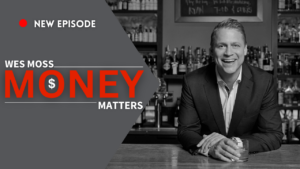Over the years, I’ve found an aspect of investing that folks struggle with the most is the anxiety that comes with watching hard earned dollars swing up and then down. It taxes even the most stoic investor.
There’s a local tall tale of a very successful Atlanta business mogul who faced this issue. His company was acquired, and in the transaction he received a significant number of shares in the new company. He then put a stock tracking ticker tape in his office and watched as the majority of his net worth rose and fell day after day. Finally, he couldn’t take the stomach-churning change and decided to sell off a huge amount of stock to invest in real estate.
He wanted an asset where he couldn’t see the value change in an instant. I do think the reality is that investors of all sizes get worn out from the emotional highs and lows of watching a stock tick higher and lower.
Time IN the market is typically more important than TIMING the market.
Of course, I’d rather buy a stock when it’s down 30% from its high like we saw in the spring of 2020, so I can reap the rewards of the market’s potential later upswing. But, we don’t have a crystal ball to tell us when we’ll reach the market bottom or when we’ll reach the market top. So, we can’t become obsessed with chasing either. But here’s the good news. In the U.S. economy, investment results even with bad timing have historically still been pretty darn good.
Don’t allow the dream of a perfect investment plan to become the enemy of a good one. Instead of focusing on the perfect time to get in, focus on how costly it can be to get out. The math behind the power of being fully invested is stunningly clear, and trusting the consistent trends it lays out is important for your long-term success as an investor.
On bad days in the market, the primary stress hormone known as cortisol can be secreted to warn you of danger. “Abandon ship!” I know because I’m human, and I feel the same survival instincts. However, years of experience have taught me the error of this approach. I asked my research team to pull some market timing data as a demonstration. The results paint a story of just how costly it can be to bail when times are tough.
Looking back at the S&P 500 annual growth rate of return from January 1995 through August of 2021 gives us a little more than 26 years of market behavior to study. Even with the tumult of multiple bear markets and recessions in that period, the market still produced an average total annual rate of return of about 9%. Using the Rule of 72, which is a simple way to determine how long an investment should take to double at a fixed annual rate of return, we can see it would take 8 years (72 divided by 9) for that to happen.
That is powerful, but what if an investor missed just a few of the best days in the market over that massive period? Our research team at Capital Investment Advisors ran the numbers and here’s what we found.
There were just over 6,700 trading days between January of 1995 to August of 2021. Missing the five best trading days during this period of time drops the rate of return from about 9% to 7.1%. Still a good number, but that’s a 21% hit relative to the full 9% per year. All because an investor got nervous and pulled money out for just five trading days.
Let’s say we miss the best 10 days. This drops the rate of return to 5.8% — a 36% decline. A person who had a momentary lapse in confidence has now lost out on a good chunk of funds to enjoy later in life.
Let’s keep going. Say we miss the best 20 trading days. The overall return would drop by 59%, bringing returns down to 3.7%. Depressing, right? Let’s move to 30 days. The rate of return falls to 2%. That’s a 78% decline and the investor is now earning less than inflation, less than long-term money markets. If you missed the top 40 days? Now it’s down 96% relative to what could’ve been made. Fifty days and it goes into negative territory.
If your strategy is trying to hop in and out of the market based on declines and rebounds, you might as well just put your money in a savings account and save yourself the trouble.
What compounds the problem and makes investing discipline so important is that very often the best market recovery days bookend the worst. On October 27, 1997, the market fell 6.9%. The next day, it rose 5%.
On August 31, 1998 the market fell 6.8%, and then on September 8 it climbed 5% in one day. On November 20, 2008, it was down 6.7%, followed by a 6.3% rise the next day. The market fell a whopping 12% on March 16, 2020, and then on March 24 it increased 9.4%, and then was up another 6.2% on March 26. It happens over and over.
The bottom line is that for the majority of investors, you are better off staying the course. Stay invested in good, high-quality companies, diversify, allocate assets, remain calm, and practice self-control over long periods.
The last thing we want to do is have a life’s work of 30, 40 or 50 years’ worth of investing ruined because of a few days on the sidelines. Flex your resolve and allow space for the huge days of redemption to succeed those of misery because we never know exactly when they’re going to show up.
Read the full AJC Article here
This information is provided to you as a resource for informational purposes only and should not be viewed as investment advice or recommendations. Investing involves risk, including the possible loss of principal. There is no guarantee offered that investment return, yield, or performance will be achieved. There will be periods of performance fluctuations, including periods of negative returns. Past performance is not indicative of future results when considering any investment vehicle. This information is being presented without consideration of the investment objectives, risk tolerance, or financial circumstances of any specific investor and might not be suitable for all investors. This information is not intended to, and should not, form a primary basis for any investment decision that you may make. Always consult your own legal, tax, or investment advisor before making any investment/tax/estate/financial planning considerations or decisions.









